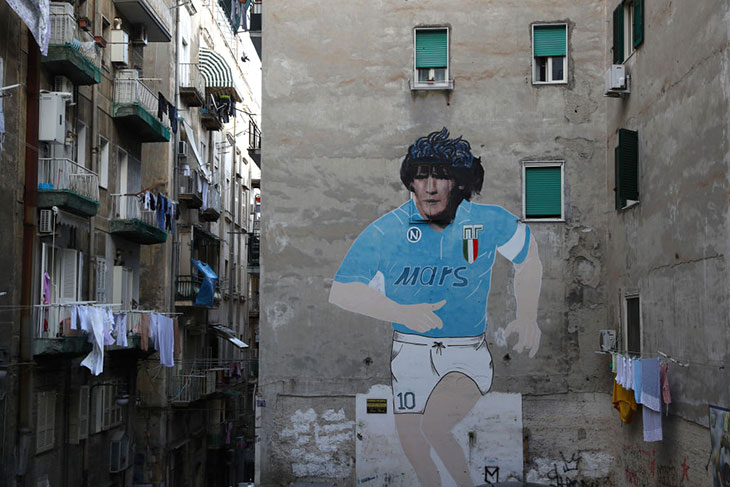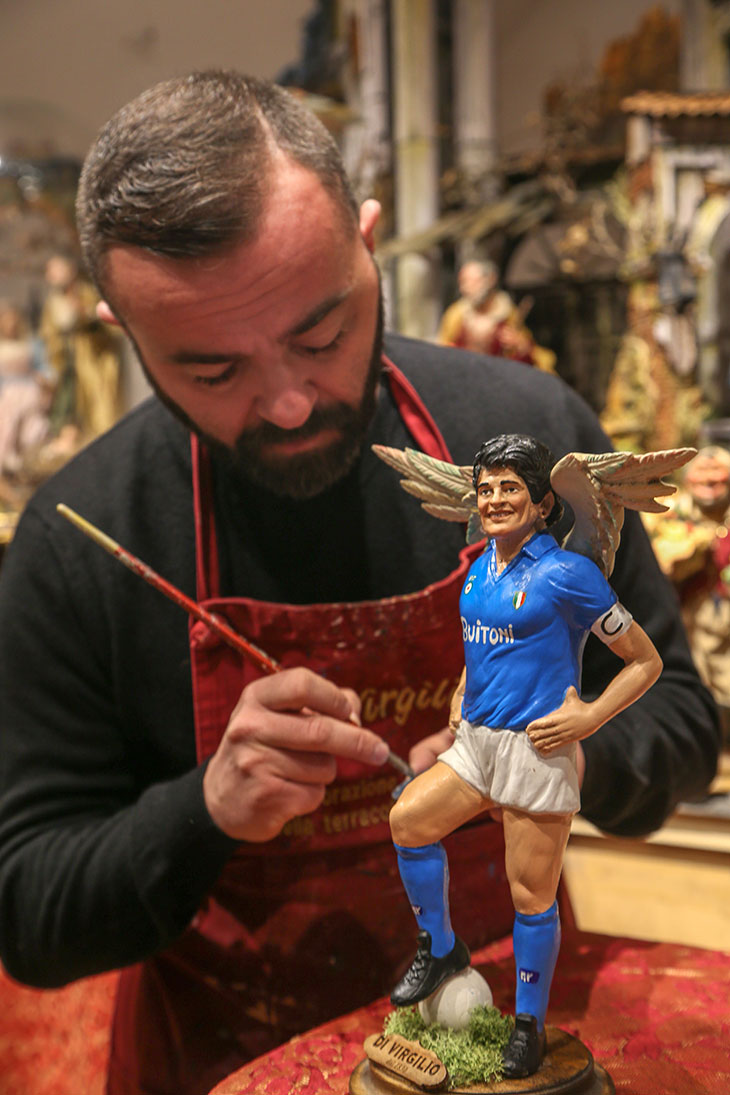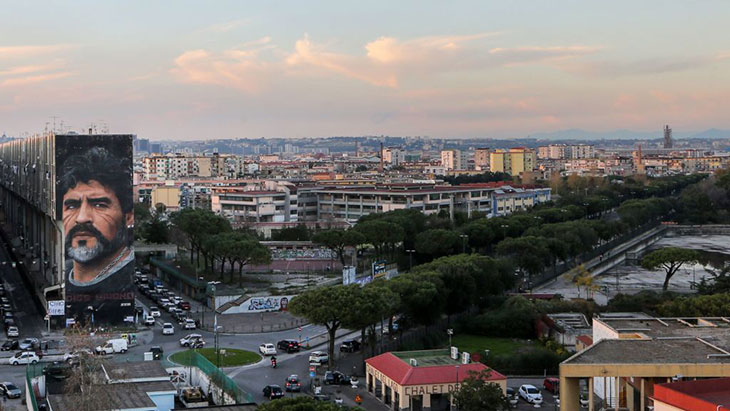A mural of Diego Maradona painted in 1990 looks over a small piazza in Quartieri Spagnoli, a working-class district in the heart of Naples. Painted in blocks of flat colour, the Argentinian footballer is shown wearing the sky-blue SSC Napoli football kit, his black, Bacchic hair standing out against the crumbling tufo stone of the apartment block. Photographs, paintings and posters of the star appear below the mural, the images accumulating from the moment Maradona led the Napoli football club to win two unprecedented league titles – first in 1987 and then in 1990. Since his death on 25 November, this square has become an impromptu site of national mourning.

A mural depicting Diego Maradona, painted in 1990 in Largo degli Artisti, Quartieri Spagnoli. Photo: Michael Steele/Getty Images
The cult of Maradona epitomised here has deeper roots than his capacity to score a winning goal. Naples has a long history of faith, superstition and devotion – there are hundreds of small shrines all over the city. The worshipping of Maradona’s image and his subsequent elevation to god-like status fit in with such practices, which themselves can be traced back to pagan rituals of antiquity, Christian traditions of the 18th century and secular revolutionary impulses of the contemporary period.
The city’s pagan devotion to icons is nowhere more exemplified than in the shrine to Maradona in Bar Nilo in the historic centre. Moulded from plaster and painted in club colours, the altar is covered in Maradona memorabilia. At its centre, inside a miniature pedimented temple, a lock of Maradona’s hair is kept in a glass phial. It mirrors the ampule found in the city’s cathedral, which contains the blood of the Neapolitan patron San Gennaro – just one of the 52 saints who protect the city and are thought to provide Neapolitans with the defences to withstand years of poverty and social struggle. The shrine, built in 1991 after the owner of the bar found the strands of hair on a flight, has become a site of pilgrimage for locals and Maradona fans all over the world, elevating the footballer to the status of a saint.
Saints play an important role in the city’s traditions, with many Neapolitans named after the most benevolent figures in their folklore. The worship of these saints – to cure headaches or protect against the plague, for example – reflects a thinly veiled polytheistic practice which dates back to the ancient Greeks who founded Naples some 3,000 years ago. With the arrival of Christianity, devotion to the gods was usurped by the devotion to saints, but just as the Greeks left sacrifices to their gods in temples, Neapolitans leave silver plated ex-voto offerings – in exchange for wishes. ‘Unlike all the other saints we are devoted to,’ the historian Amedeo Colella says, somewhat tongue-in-cheek, ‘Maradona is the one who has actually delivered tangible miracles.’

Genny Di Virgilio painting a statuette of Diego Maradona with wings on 26 November in Naples. Photo: Carlo Hermann/AFP via Getty Images
Further along from Bar Nilo, among the workshops of nativity artisans on Via San Gregorio Armeno, Genny Di Virgilio continues the custom of inserting everyday, contemporary motifs into presepi (cribs), a convention dating back to the mid 1700s. On advice from the church, the ruling Bourbon Spanish monarchy encouraged artisans to include scenes of domesticity, sociability and work life in their nativity dioramas, so that believers might find the biblical story more relatable. After the arrival of Maradona in the city in 1984, artisans began incorporating maquettes of him into their creations. Di Virgilio, who considers himself the first artisan to have done this in the early 1990s, has, since the footballer’s death, been inundated with orders for his Maradona statuettes. ‘With a heavy heart, I realised I now had to make a version of Maradona with wings,’ he says. ‘He taught us to dream and he is now flying with angels in heaven.’ At the centre of an elaborate nativity situated above his workbench is a Maradona figurine complete with wings, dressed in his classic Buitoni sweatshirt.
On the outskirts of Naples, an imposing portrait of Maradona in his late fifties can be found on the eastern walls of the housing estate Taverna del Ferro, in the impoverished neighbourhood of San Giovanni a Teduccio. The mural, entitled Human God, was painted by the local street artist Jorit Agoch and takes over the entire ten-storey facade of an apartment block, which also features a mural of Che Guevara at the opposite end. It was commissioned by residents who believed the mural would ‘encourage us all to stand up to every type of exploitation and oppression, and to encourage renewed social and political struggle’. Born into poverty in a shanty town in Buenos Aires, Maradona was uniquely placed to unify the people of his adopted city and to inspire hope in a place where there is scant social mobility.

Jorit Agoch’s 2017 mural of Diego Maradona in San Giovanni a Teduccio, photographed in November 2020. Photo: Carlo Hermann/AFP via Getty Images
Noting his widespread veneration, I couldn’t help but mythologise Maradona in my own mind: I have always presumed that the commonly heard exclamation ‘Oh, Maro’ was an abbreviation of ‘Oh, Maradona’. It is in fact short for ‘Oh, Madonna’ in Neapolitan dialect. But to take the mythologised footballer’s name in vain seemed to me an entirely logical move in a city where his murals, shrines and maquettes compete for space with the more traditional religious iconography adorning the crumbling stucco walls. I was wrong when it came to the translation but in elevating Maradona to unearthly heights, to a saint capable of miracles and deliverance, I was spot on.

How Naples made a saint of Maradona
An altar to Diego Maradona set up in the Quartieri Spagnoli of Naples after the footballer’s death on 25 November 2020. Photo: Carlo Hermann/AFP via Getty Images
Share
A mural of Diego Maradona painted in 1990 looks over a small piazza in Quartieri Spagnoli, a working-class district in the heart of Naples. Painted in blocks of flat colour, the Argentinian footballer is shown wearing the sky-blue SSC Napoli football kit, his black, Bacchic hair standing out against the crumbling tufo stone of the apartment block. Photographs, paintings and posters of the star appear below the mural, the images accumulating from the moment Maradona led the Napoli football club to win two unprecedented league titles – first in 1987 and then in 1990. Since his death on 25 November, this square has become an impromptu site of national mourning.
A mural depicting Diego Maradona, painted in 1990 in Largo degli Artisti, Quartieri Spagnoli. Photo: Michael Steele/Getty Images
The cult of Maradona epitomised here has deeper roots than his capacity to score a winning goal. Naples has a long history of faith, superstition and devotion – there are hundreds of small shrines all over the city. The worshipping of Maradona’s image and his subsequent elevation to god-like status fit in with such practices, which themselves can be traced back to pagan rituals of antiquity, Christian traditions of the 18th century and secular revolutionary impulses of the contemporary period.
The city’s pagan devotion to icons is nowhere more exemplified than in the shrine to Maradona in Bar Nilo in the historic centre. Moulded from plaster and painted in club colours, the altar is covered in Maradona memorabilia. At its centre, inside a miniature pedimented temple, a lock of Maradona’s hair is kept in a glass phial. It mirrors the ampule found in the city’s cathedral, which contains the blood of the Neapolitan patron San Gennaro – just one of the 52 saints who protect the city and are thought to provide Neapolitans with the defences to withstand years of poverty and social struggle. The shrine, built in 1991 after the owner of the bar found the strands of hair on a flight, has become a site of pilgrimage for locals and Maradona fans all over the world, elevating the footballer to the status of a saint.
Saints play an important role in the city’s traditions, with many Neapolitans named after the most benevolent figures in their folklore. The worship of these saints – to cure headaches or protect against the plague, for example – reflects a thinly veiled polytheistic practice which dates back to the ancient Greeks who founded Naples some 3,000 years ago. With the arrival of Christianity, devotion to the gods was usurped by the devotion to saints, but just as the Greeks left sacrifices to their gods in temples, Neapolitans leave silver plated ex-voto offerings – in exchange for wishes. ‘Unlike all the other saints we are devoted to,’ the historian Amedeo Colella says, somewhat tongue-in-cheek, ‘Maradona is the one who has actually delivered tangible miracles.’
Genny Di Virgilio painting a statuette of Diego Maradona with wings on 26 November in Naples. Photo: Carlo Hermann/AFP via Getty Images
Further along from Bar Nilo, among the workshops of nativity artisans on Via San Gregorio Armeno, Genny Di Virgilio continues the custom of inserting everyday, contemporary motifs into presepi (cribs), a convention dating back to the mid 1700s. On advice from the church, the ruling Bourbon Spanish monarchy encouraged artisans to include scenes of domesticity, sociability and work life in their nativity dioramas, so that believers might find the biblical story more relatable. After the arrival of Maradona in the city in 1984, artisans began incorporating maquettes of him into their creations. Di Virgilio, who considers himself the first artisan to have done this in the early 1990s, has, since the footballer’s death, been inundated with orders for his Maradona statuettes. ‘With a heavy heart, I realised I now had to make a version of Maradona with wings,’ he says. ‘He taught us to dream and he is now flying with angels in heaven.’ At the centre of an elaborate nativity situated above his workbench is a Maradona figurine complete with wings, dressed in his classic Buitoni sweatshirt.
On the outskirts of Naples, an imposing portrait of Maradona in his late fifties can be found on the eastern walls of the housing estate Taverna del Ferro, in the impoverished neighbourhood of San Giovanni a Teduccio. The mural, entitled Human God, was painted by the local street artist Jorit Agoch and takes over the entire ten-storey facade of an apartment block, which also features a mural of Che Guevara at the opposite end. It was commissioned by residents who believed the mural would ‘encourage us all to stand up to every type of exploitation and oppression, and to encourage renewed social and political struggle’. Born into poverty in a shanty town in Buenos Aires, Maradona was uniquely placed to unify the people of his adopted city and to inspire hope in a place where there is scant social mobility.
Jorit Agoch’s 2017 mural of Diego Maradona in San Giovanni a Teduccio, photographed in November 2020. Photo: Carlo Hermann/AFP via Getty Images
Noting his widespread veneration, I couldn’t help but mythologise Maradona in my own mind: I have always presumed that the commonly heard exclamation ‘Oh, Maro’ was an abbreviation of ‘Oh, Maradona’. It is in fact short for ‘Oh, Madonna’ in Neapolitan dialect. But to take the mythologised footballer’s name in vain seemed to me an entirely logical move in a city where his murals, shrines and maquettes compete for space with the more traditional religious iconography adorning the crumbling stucco walls. I was wrong when it came to the translation but in elevating Maradona to unearthly heights, to a saint capable of miracles and deliverance, I was spot on.
Unlimited access from just $16 every 3 months
Subscribe to get unlimited and exclusive access to the top art stories, interviews and exhibition reviews.
Share
Recommended for you
Messier and Messier – at the FC Barcelona Museum
A visit to Camp Nou – where Lionel Messi’s boots can be found alongside works by Miró, Dalí and Tàpies
‘The boxer is the closest I can get to a superhero’ – an interview with Godfried Donkor
The British-Ghanaian artist discusses his fascination with historical images of boxers – and how he works them into contemporary paintings and collages
From pelle melle to the London Marathon – sports days in St James’s Park
As runners in the London Marathon prepare to make 19 loops of St James’s Park, Rakewell delves into the sporting provenance of the park